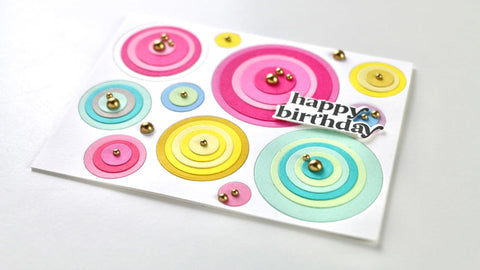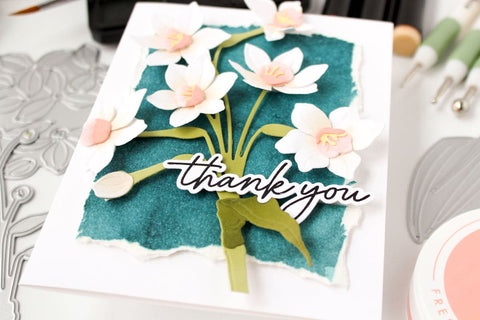Which Die-Cutting Machine Should I Buy?
Last Updated: October 28, 2025
Finding the best die-cutting machine for your crafting needs isn’t easy, especially with the increasing number of choices in the market today. Should you get a big one or a small one, a manual or an electronic one? It might be overwhelming and a bit confusing, but we’re here to help!
Before you embark on your search for the best die-cutting tools, let’s learn a bit more about dies for card making, die-cut machines, Altenew dies, and a brief history of die-cutting!

Mini Blossom Die Cutting Machine
What is a Die-cutting Machine?
Die-cutting machines are a staple in most paper crafters’ craft rooms. These handy machines allow crafters to die cut designs with the craft dies in their collections. The different types of die cut machines available in the market allow crafters to use them with different types of dies, crafting techniques with dies, and specific crafting styles.
Brief History of Die-cutting
According to Colvin Friedman, die-cutting started as a way “to cut leather for the shoe industry more efficiently.” Back then, making shoes was very labor-intensive and time-consuming since the holes in the leather were individually punched by hand. The manual process yielded many inconsistencies between the shoes, hence the introduction of die-cutting. Since then, cobblers were able to “create sole patterns that could be reliably replicated through the die-cutting process.” With the advent of the mallet handle die-cutting machine came the mass production of soles and standardized sizes for the masses.
It wasn’t until the early 1900s when further innovations in dies and die-cutting machines were invented. The 1950s saw the invention of hand-held die-cutting tools and small table machines, which were mainly used for homes and schools. What started as a convenient and straightforward way to help cobblers speed up the shoemaking process has turned into a staple tool in every crafter’s home.
CLICK HERE to learn more about die cutting, dies for card making, die-cutting paper, and everything you need to know about dies.

Which Die-Cutting Machine and Die-Cutting Tools Suit Your Needs?
Manual or Digital
Manual or digital die-cutting machine? That is the question. It seems like an easy question to answer, but it is also very subjective. While a digital die cut machine is the obvious choice for most, some might see the beauty in using manual die-cutting tools.
Here are some pros and cons that will give you a better understanding of manual and digital die cut machines.
|
Die Cut Machine Type |
Pros |
Cons |
|
|
|
|
Digital Die Cutting Machine |
|
|
Finding the Best Die Cutting Tool That Suits Your Needs
There’s a reason why die cut machines are a staple in a crafter’s room. It can cut, score, emboss, write, scan, and deboss! This all-around machine is simply a must-have. If you’re trying to figure out which die-cutting machine to buy, you need to consider a few things first. Ask yourself these questions:
- Is it beginner-friendly? Even if you’re not technically a “beginner” in crafting, if you haven’t used any die-cutting tools before, you might get frustrated if it’s too complicated.
- Is it user-friendly? Not all beginner-friendly machines are user-friendly. Keep that in mind.
- Is it affordable? You want the best of the best, and you’re ready to invest. But don’t get fooled by the fancy features of die-cutting machines. You want something high-quality, but with a decent and fair price point.
- Is it portable or travel-friendly? If you’re just crafting at home, then this probably won’t matter to you. However, it’s also something to consider if you have sudden out-of-town trips or vacations and you decided you want to do a bit of crafting on the go.
- Is it for a large or small project? It’s essential to determine whether or not you’ll be making large DIY crafts or just small ones. Keep in mind that most large die-cutting machines will, of course, cost more than smaller ones.

Mini Blossom Die Cutting Plates
Other things to consider
There are a couple of other things to consider when choosing which die-cutting machine to buy. One of them is the machine’s functionality. Are you going to use it strictly for die-cutting only? Do you need it for die-cutting and embossing? Or are you in need of a multipurpose die cut machine that can die-cut, emboss, score, and even scan?
Interestingly enough, die-cutting is not limited to paper crafting. In fact, it is used widely in the manufacturing world to cut elements such as sheet metal, rubber, plastic, cloth, and many other substances for mass production. Although most paper crafters would stick to “paper” as their material (hence the term “paper crafting”), others try to get creative and use a few unique materials in their crafts. If you are feeling adventurous and want to try other mediums, you need to consider the ability of the die-cutting tools that you’re using. Here are a few common materials that can be used with a die-cut machine.
- paper
- felt
- fabric
- wood
- leather
- vinyl
- cork
- foam

Other Tools for Die Cutting
We cannot talk about die cut machines without mentioning a few other tools that you’ll need. Having a die-cutting machine is just one piece of the puzzle. You will also need the following:
1. Die-cutting paper - Obviously, you already know that die cutting involves cutting a shape or a design out of paper using a die-cutting machine. Think of it as cutting shapes out of paper with your scissors, but the shapes are more complex and intricate with die-cutting. To create beautiful and detailed die-cuts, you will need high-quality paper or cardstock. Die-cutting paper isn’t just regular paper. It is highly recommended to get a set of 80lb to 110lb cardstock paper like THIS ONE. This will ensure that whatever dies for card making you use will cut out the shape cleanly and precisely. Altenew dies are designed to work well with most of the die cut machines in the market today.
2. Dies for card making - The quality of the dies you use with your die-cutting machine is just as important as the machine itself. Finding the best dies for card making might be overwhelming, especially with the plethora of dies being sold in the market today. Altenew dies are a favorite among paper crafters because they are wafer-thin, intricately designed, and cuts clean every time.
Types of Dies for Card Making
Wafer-thin dies usually fall under three main categories: stand-alone dies, coordinating dies, and nesting dies.
1. Stand-alone dies are dies that can be used and enjoyed on their own. They come in tons of different shapes and sizes that can be used for a wide variety of paper crafting projects.
As the name suggests, coordinating dies coordinate or match with a specific stamp image or stamp set. This is especially useful for paper crafters who have arthritis or other disabilities. It is often less stressful on the hand to use dies than to cut out images with scissors.
2. Nesting dies also take advantage of an open center. This allows manufacturers to nest multiple sizes of the same shape within each other. This cuts down the die set cost and provides the crafter with many size options for their projects!
3. Die-cutting plates - These plates are made out of acrylic and can be used to quickly and easily die-cut various materials, including cardstock and specialty papers. These die-cutting plates are used to “sandwich” the dies and paper in between. The plates will then be inserted into the die-cutting machine, which will cut the die’s intricate design into the paper.
The "A" plate is used as the cutting plate. The "B" plate should be placed on the top of the die, and the "A" plate should be facing the blade of the die.
4. Metal shim - This is an additional tool for your die-cutting needs. A metal shim is designed to help you cut intricate dies in your die-cutting machine. Simply add this to the cutting sandwich (die-cutting plates) between the top of the die (non-cutting edge) and the top plate to gain a little extra pressure for those finely detailed dies.
5. Washi tape or purple tape - Although die-cutting plates and metal shims will do an excellent job of keeping the die and paper in place, it is still advisable to use tape to keep them from moving. Therm O Web’s Purple Tape is a popular choice among paper crafters. However, you can also use any adhesive you have on hand, as long as they’re removable and won’t leave any residue. Slim washi tapes like THESE ONES are another option that you can try.
Die-cuts are an excellent addition to any paper crafting project, whether it’s a handmade card, a scrapbook page, a journal, or a DIY craft. These can add a beautiful dimension and layer, making your projects more realistic-looking and giving it that WOW factor. That’s why it’s essential to get the best die-cutting machine that suits your paper crafting wants and needs.
1 comment
In This Article
More Crafty Reads & Inspirations
-

Starting 2026 With a Clean Slate and Using Up Leftovers
-

January 2026 Inspiration Challenge
-

Simple Tips To Bring Your Die Cut Florals To Life - A Touch of Sparkle With Carissa Wiley
-

3 Secrets for No-Outline Watercoloring: The Art of the Disappearing Line | Perfect Pairings with Jaycee
-

Card Ideas that Symbolize New Beginnings
















It sure was interesting to know that further innovation in dies and die-cutting machines was invented until the early 1900s. This is a nice piece of information for people who are interested in using die cutters for packaging purposes. I would imagine packaging companies benefit from this type of equipment to ensure that every labels gets to be printed properly for their products. http://mollbrothers.com/product/moll-flexcut-system/#scroll-bottom